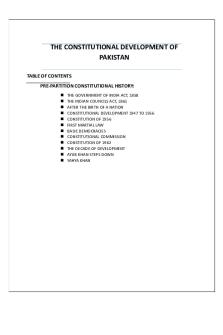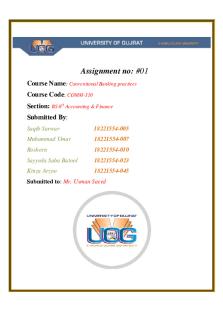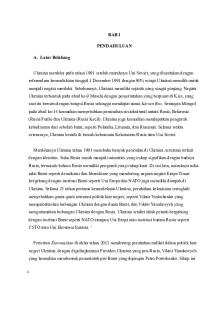National Security Policy of Pakistan 2022 - 2026 : Technical Review PDF

| Title | National Security Policy of Pakistan 2022 - 2026 : Technical Review |
|---|---|
| Author | Puruesh Chaudhary |
| Pages | 4 |
| File Size | 135 KB |
| File Type | |
| Total Downloads | 566 |
| Total Views | 633 |
Summary
National Security Policy of Pakistan 2022 – 2026; Technical Review Puruesh Chaudhary The message by the prime minister nor the national security adviser is inspiring. At best a dull document with a lofty vision none bold whatsoever. The document is disconnected from the current trends. Random refere...
Description
National Security Policy of Pakistan 2022 – 2026; Technical Review Puruesh Chaudhary The message by the prime minister nor the national security adviser is inspiring. At best a dull document with a lofty vision none bold whatsoever. The document is disconnected from the current trends. Random references barely constitute as a full fledge understanding of the trends. The ‘Policy’ assumptions are set in a pre-covid world, which hardly acknowledge how the pandemic has disrupted the functions of the country and it’s the lives of its people in the last two years. With zero definitions, this policy raises more questions regarding the overall process towards national security than providing any degree of concreteness towards our national aspirations. Such as, like what does the Prime Minister mean by Openness in his opening remarks. Writing bold visions, does not really make it so, merely regurgitation of the same thinking in a different sequence on an altered format. It is distracting. And pointless. The vision lacks imagination. It is safe. Uncreative. Does not reflect on the aspirations of a young demographic. The future decisionmakers of this country that will take us into the 22nd century. The construction of the vision is a consolidation of the entire document, incorporating parts from each section. It only appeases its constituency. This shows the weakness of the overall thought process. It errs when it comes to design. The vision could’ve easily reflected the essence of the framework if the design provided the opportunity to do so. A well written vision is short and simple. It captures imagination. It sparks interest. It is exciting. It mobilizes people. How is a vision possible without a definition of essential components that will provide it credence? Although adopting a citizen-centric approach is a thinking in the right direction in terms of a scenario that establishes an environment which is incredibly tech-enabled where the future security concerns are diametrically different from the perception of threats today. The potential of this scenario is more likely possibly given the current trends if they were to be studied and understood with a strategic foresight lens. The policy however does not do justice with this scenario in the offing. Neither the Prime Minister nor the National Security Advisor emphasize on technology and how it connects with the citizen-centric approach in a resource constraint environment. The section on important terms do not provide definitions rather what they imply. Nowhere in the document has ‘national security’ been defined that can provide clarity of thought and purpose. Which also reveals that there’s very little data-based approach used in this process of policy development. Hence futures thinking interms of techniques or methodologies appear to be severely missing in the overall design. What is equally significant and was missing was the philosophy that provides the foundation to the thought process. Merely using Delphi alone does not aide the construction of the thought behind the policy development. A philosophical paradigm would’ve provided it substantive support. When elements such as preservations come in the policy discussion it means that the scientific community was not consulted and, in this case, neuroscientists, cognitive specialists or psychologists. The timeframe seven years is quite a lot considering the outcome is a horizon spanning four years only despite including 120 experts and 500 specialists. These numbers mean nothing if the policy document does not reflect a coherent thought. Could this mean that the National Security Division of Pakistan has capability challenges of its own. Promoting openness is in direct contradiction to preservation. Clarity of existing concepts such as openness, preservation, wellbeing should’ve been thought through, and used rather sparingly. A contestation of narratives is not a challenge, it’s a creativity gridlock. The framework highlighting that the ‘challenge is to move away from the traditional guns versus butter’ suggests exactly that. This was a narrative trap set by exceptionally creative storytellers now which is articulated in Pakistan’s
national security framework. This, in itself, is a huge win for the stakeholders who inculcated this divisive thought in the Pakistani society. This is how strong of a strategic narrative it was. The model showing economic security and its symbiotic relationship with the traditional and nontraditional security appears to be incomplete, feels a bit rushed. And if this is being considered a framework, conceptual strategists in the domain would inform otherwise. A framework is a comprehensive image of a conceptual structure that gives the underlying philosophy a meaning and a direction. Implying that the whole-of-government approach is to be used as one of the principles of policy implementation – without reviewing, in seven years, the current coordination mechanisms, is a principle merely based on opinions and not supported by empirical evidence. Can a principle be articulated without credible data to assist? This document is all about what ‘can’ happen and not what ‘will’ happen lacks confidence in itself. While it does recognize the fluid global environment, fast-changing geo-political realities, yet it fails to mention foresight even once yet rather fills this void with a vague outdated construct of ‘longterm strategic thinking and planning’ bearing in mind the design thus used and the horizon it produced. This underlines how the construction of this policy document was based on an outdated template. Prioritization does not really give an insight as to how this will be done and who will do it, and how it connects with the citizen-centric approach. Policy continuities are required in a stable environment. However, as this document already claims that we live in times where the global environment is fluid, and the geo-political realities are fast-changing - begs the question that if in more than 70 years of country’s history it hasn’t been able to achieve policy continuities, could it possibly mean that the technique (or template) used then and even now to develop this framework is also obsolete. It takes one back to the vision. This document should’ve been policy of opportunities and how it will leverage from those, rather than clubbing challenges along with and confusing both. Yes, to contextualize an opportunity, it’s an important feature but to combine the two misplaces the focus on the outcome. Identity and culture are sensitive matters, acutely nuanced and cannot be dealt with as it has been in this policy. None of what is mentioned in this section is new. ‘Issues of identity’ as a cause for disharmony is a poorly judged assumption. That means we are still not prepared to address the underlying causes of what aspects of our decisions, or our approaches trigger the faultlines in the society. How do you preserve evolution? Identity is not a relic, the guideline suggesting ‘preserving our identity’ is contrary to the human phenomena and one which needs to be approached very cautiously. The most important aspect of the document are the values which it fails to orchestrate explicitly in the framework, how you identify them, how you capture the changes in the society and its effect on the traditional models is an essential enterprise that requires a deliberative process. The inequalities have not been defined, and to mention Pakistan has made significant gains in poverty reduction is a bit of a faux pas to an educated Pakistani considering the impact of the recent pandemic. The continuous reference around good governance without taking into account how the models have evolved over the last decade where the key international players are positioning ‘anticipatory governance’ as one of the critical instruments to manage a country’s national security affairs (both internal and external) in the current and in the times to come. This section demonstrates a very meagre attempt in framing the cohesion effort.
When addressing inequalities in ‘securing our economic future’ preventing elite capture is simply a meaningless text, had the design been carefully thought through the policy document would’ve reflected that very prevention that it promises. Integrating grassroot surveys on what inequalities and inequities mean to them would have proven to be an asset for future decisionmaking. This phase of the policy development was completely neglected. A redistributive model while aiming for an export-led growth with two million new young Pakistanis entering the workforce each year in a highly competitive environment requires – again, clarity of thought and purpose. The focus on which aspect of the economy will improve the country’s overall competitiveness is crucial if our products and services are to compete in international market spaces. Hence why coherency in thought matters in policy articulation. Lapse in enunciating the Presidential programme on Artificial Intelligence while highlighting how emerging technologies will reshape societies is a significant disconnect from the policy objective of preserving our identities while acknowledging that the country prepares for the fourth industrial revolution. What is missing is the application of theory of change not only in this context but in other sections also. The inclusion of cyber and space in the discourse is a welcome addition, this moves the country away from the paraphernalia of traditional threats. These contours are more citizen-centric and therefore can enable futuristic ideas in its overall thinking. It would’ve been a single biggest achievement for this document had those factors been interwoven into the comprehensive framework. This alone would’ve set the tone for future direction of the national security policy for the country. The document undertakes current times as the age of information but has very little assimilation of the same across all the sections of the policy. The question therefore is, do we have a complete understanding of what this means, or is it just a way of getting through this policy? Cross-impact analysis would’ve solved this aspect. For the scenarist or futurists around the world ‘Defending territorial integrity at “all cost”’ is a challenge that hostile entities would gladly undertake, perhaps toning this down would be beneficial for Pakistan’s future, a mindful consideration in policymaking can make all the difference for internal security purposes. Countering terrorist propaganda by merely flooding information channels with anti-terror narratives is a naïve recommendation.
… a narrative should not be static, but at its core it should be mutative and responsive to the environment. ‘The purpose of a strategic narrative is to create and shape identities not in isolation but as a behavioural norm, which could be based upon short-term tactical gains or longterm sustainable visions with the range of possibilities’. Narratives and stories form a foundation that can either unite or divide any given society through offering either hope or despair for the future… (https://stratcomcoe.org/cuploads/pfiles/daeshrussiacomparisson.pdf - What is strategic narrative? https://www.academia.edu/26503495/Strategic_Narrative_A_Perspective ) A changing world although mentioned in the foreign policy section is one which is least considered in all the other sections. And if international politics is an extremely fluid state, then how does preserving our identities prepares the nation in the age of information as recognized in the policy. Perhaps framing this in a manner that the state promises to protect rather than preserve our identities would connect seamlessly in a changing world. One cannot project one’s own reality when one does not have the capacity to recognize these changes. And in the chain of values, why is trust with China an important concern and not a feature in all bilateral relations? Clubbing a region as big as Africa among others in ‘Other important regions’ has so little imagination. To internalize how this cradle of civilization can potentially shape Pakistan’s future prosperity seems like a difficult challenge. Championing national causes as a global concern is a matter of pride and achievement. A cause is determined by observing the most marginalized in the society. Identifying cause of the people and not just select few if the agenda is to undermine the elite capture of the dominant discourse. Fear of Islam (Islamophobia) is not Pakistan’s issue, efforts in this direction holds very little value for the
constituencies at home. Henceforth giving strategic communication space in the conduct of diplomacy is a vital addition if carried out professionally. Dealing with challenges around perception requires a scientific approach whilst engaging the most creative and imaginative communities from the society. This demands talent and openness to creating newer experiences for the changing demographics. Interms of priority of maintaining the framework citizen-centric what should’ve come first or second comes last shows thoughtlessness and extreme disconnects in the policy development process. Seven years in, 120 experts and 500 specialists later, how can the sequence look like the way it does? Having 140 extreme weather events over the past two decades is critical, this affects everything from our geography to our security to our economy to the livelihoods of Pakistanis. It’s extremely important to make weather as one of the key components of all future policy formulations. This approach is a sound management tool for preparedness. Same goes for stunting and malnutrition, this condition is a national security risk, as it prevents the country from achieving its full potential. While the transgender community is given support in the policy, yet it doesn’t recognize or take into account all the meaningful effort done by Pakistan in this direction over the years. This document makes a lot of claims, holds no one responsible or accountable in the process. Using words like melting pot without introspection that it is a dated metaphor or comity of nations, indicates limitation of the use of the language, one which does not reflect the aspirations of a young Pakistan rather one that is old and feeble. You become the vocabulary you use, a cognitive reinforcement of a perception which is disconnected from the realities. This is not a forward-looking document, nor it is an intelligent one; it is one at best stuck in validating past approaches which is why it comes across more of an analysis than a policy for Pakistan’s national security outlook. The supposition that some of the text of the national security policy document undertakes is one that, that the future is unidirectional and that each section stands in isolation on its own which is neither inter or intra-relational is quite frightening. The alarming disconnects sets the country in the first industrial revolution mode. This is not a template worth evolving. The existing architecture is too dated and fragile to adapt the changes of the futures. How to improve our National Security thinking? Governments around the world are realizing the importance of anticipatory governance in times of exponential growth opportunities and the dark challenges that lie ahead. This means, that their approaches to policy development is anchored in foresight or futures techniques and methodologies. Each year we see newer futures frameworks emerge, the scholarly work in this domain is significantly relevant to chalking futures-oriented strategic direction. With a National Security Division that also houses an Imagination unit - one of the ways forward, however, the first step would be to seriously consider incorporating futures thinking in policy development....
Similar Free PDFs

Covid National Security
- 4 Pages

The National Development Policy
- 2 Pages

National Environment Policy 2006
- 8 Pages

Pakistan Foreign Policy 1947 to 2004
- 30 Pages

FIN 639 AI and National Security
- 1 Pages

Constitutional History of pakistan
- 16 Pages

Policy Review #1
- 5 Pages

25 Banks of PAKISTAN
- 25 Pages
Popular Institutions
- Tinajero National High School - Annex
- Politeknik Caltex Riau
- Yokohama City University
- SGT University
- University of Al-Qadisiyah
- Divine Word College of Vigan
- Techniek College Rotterdam
- Universidade de Santiago
- Universiti Teknologi MARA Cawangan Johor Kampus Pasir Gudang
- Poltekkes Kemenkes Yogyakarta
- Baguio City National High School
- Colegio san marcos
- preparatoria uno
- Centro de Bachillerato Tecnológico Industrial y de Servicios No. 107
- Dalian Maritime University
- Quang Trung Secondary School
- Colegio Tecnológico en Informática
- Corporación Regional de Educación Superior
- Grupo CEDVA
- Dar Al Uloom University
- Centro de Estudios Preuniversitarios de la Universidad Nacional de Ingeniería
- 上智大学
- Aakash International School, Nuna Majara
- San Felipe Neri Catholic School
- Kang Chiao International School - New Taipei City
- Misamis Occidental National High School
- Institución Educativa Escuela Normal Juan Ladrilleros
- Kolehiyo ng Pantukan
- Batanes State College
- Instituto Continental
- Sekolah Menengah Kejuruan Kesehatan Kaltara (Tarakan)
- Colegio de La Inmaculada Concepcion - Cebu







